Clematis Armandii Growing Advice With The International Clematis Society
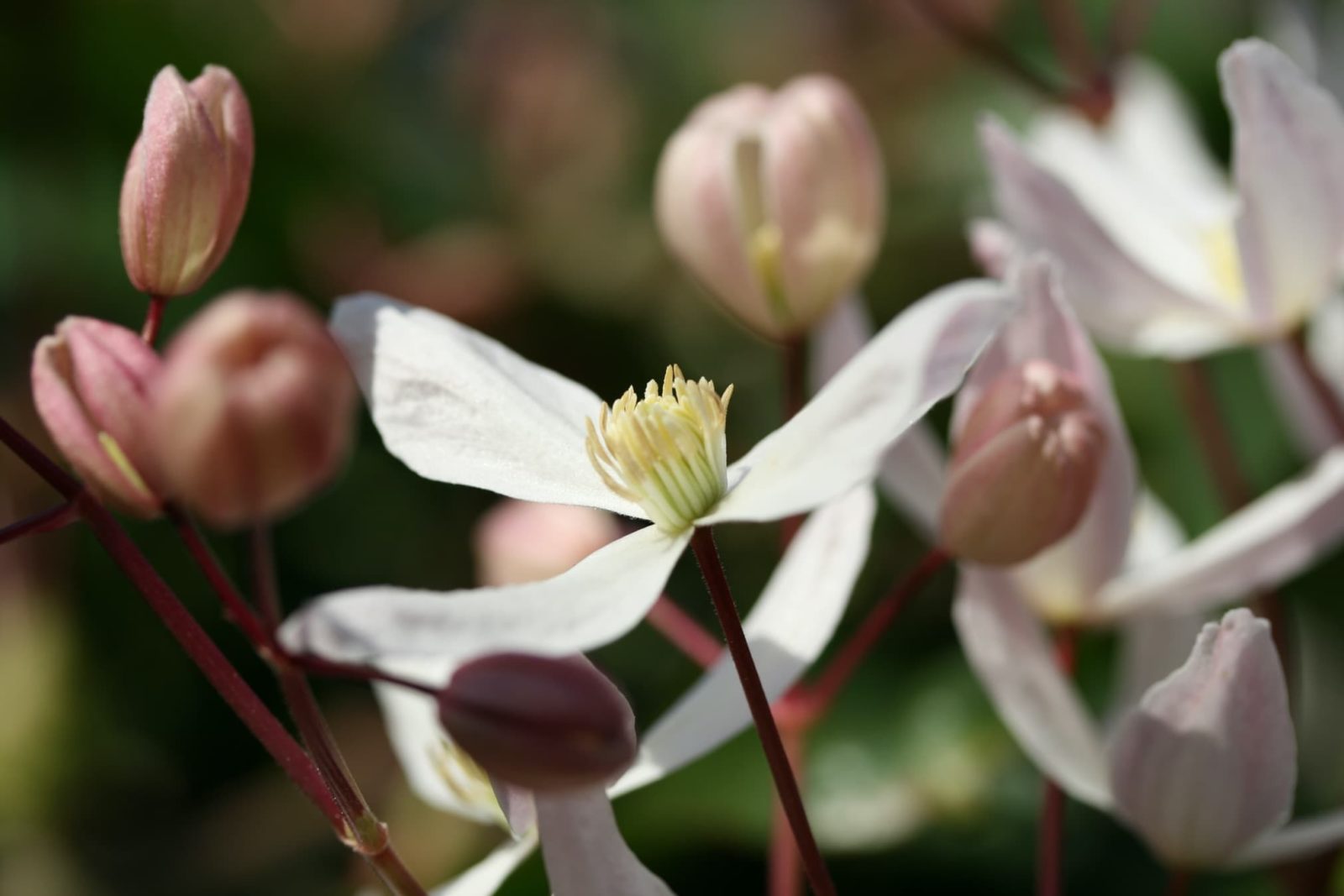
CLIMBERS > CLEMATIS > ARMANDII
Chris is a gardening writer and nature enthusiast. He graduated from Oxford Brookes University in 2022 with an MA in Psychology. Chris works with the Leeds Green Action Society, helping their food cooperative by growing various fruit and vegetables on their two allotments in Hyde Park, Leeds.
Reviewed By COLIN SKELLY

Colin is a Horticulturist and Horticultural Consultant with experience in a range of practical and managerial roles across heritage, commercial and public horticulture. He holds the Royal Horticultural Society’s Master of Horticulture award and has a particular interest in horticultural ecology and naturalistic planting for habitat and climate resilience.
Contributions From PETER SKEGGS-GOOCH

Peter is the third-generation Owner of specialist nursery Thorncroft Clematis who are 12 x RHS Chelsea Gold Medal winners and known worldwide for their expertise and knowledge in the field of clematis. Peter is also a sought-after public speaker on the topic of clematis and is a guest speaker for The English Garden School at Chelsea Physic Garden in London.

Fiona is the Secretary of the International Clematis Society and a member of the British Clematis Society. She has been growing Clematis for 40 years and even has a Clematis named in her honour!
IN THIS GUIDE
CLEMATIS GUIDES
Playing with vertical plants is a fantastic way of adding depth and dimension to your garden or outdoor space.
When we think of plants and floral displays, our imaginings often centre on ground level.
Flowerbeds at our feet where colours and shapes intermingle, competing and complementing each other to capture our attention.
Occasionally a tall flower may stand proudly above the rest, but the majority of the visual interest is below our knees.

It doesn’t have to be this way, though. You’re not restricted to ground-level displays.
In this post, we’ll introduce you to Clematis armandii: a stunning evergreen vine with cascading white floral blooms that looks simply incredible, whether used as a backdrop or a centrepiece.
Overview
| Botanical Name | Clematis armandii |
| Common Name(s) | Armand Clematis |
| Plant Type | Climber / Perennial |
| Native Area | Central & Western China |
| Hardiness Rating | H4 |
| Foliage | Leathery, dark green evergreen leaves |
| Flowers | Usually white or pink, star-shaped |
| When To Sow | March, April, May, September, October |
| Plant Out | March, April |
| When To Prune | February, March |
| Flowering Months | March, April, May |
Sunlight
Preferred
Full Sun
Exposure
Sheltered
Size
Height
4 – 8M
Spread
1.5 – 2.5M
Bloom Time
March – May
Soil
Preferred
Most soil types
Moisture
Moist but well drained
pH
Any
Armand clematis, or Clematis armandii is an attractive vine that spills forth with white flowers in spring and early summer, against a backdrop of rich evergreen leaves.
The accomplished combination of colours and shades makes this plant a great fixture in any outdoor space, whether you’ve got access to soil or you’re limited to containers.
The plant is native to China but has found fans all over the world, and its hardiness preferences suit it well to growth in British conditions.1Clematis armandii. (n.d.). North Carolina Extension Gardener Plant Toolbox. Retrieved March 14, 2023, from https://plants.ces.ncsu.edu/plants/clematis-armandii/
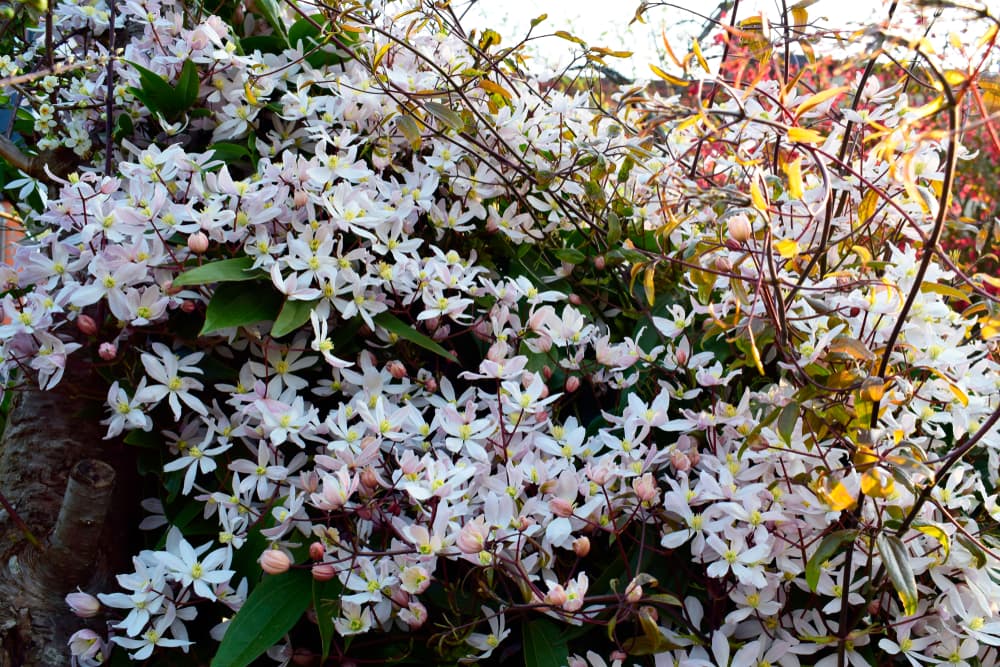
Incorporate this plant into your garden and we can assure you that you won’t regret your decision.
It’s a pleasure to look at, easy to grow, and ready to combine with myriad other blooms.
Why Grow Armand Clematis?
There are a few good reasons to grow C. armandii.
Firstly, it’s easy to grow. It’s not finicky, and you won’t find yourself outside in all weathers trying to desperately keep your plant alive.
Just take care of a couple of requirements (which we’ll come to shortly) and you’re good to go.

The second reason to grow C. armandii is simple: it’s beautiful.
There’s something uniquely captivating about vines – the way they take vertical surfaces in their stride, playing with our expectations about space and how to use it.
As your clematis becomes established and confidently asserts itself in your garden, you’ll come to love its vertical presence.
Third? The flowers.

These small white blooms that burst forth in spring are gentle and delicate.
They’re a great advance party for the annual bloom, too, leading the way for all the other flowers in your garden.
“Clematis armandii is both early-flowering and vigorous type that gives a good display and is generally scented, producing a fantastic aroma,” says Fiona Woolfenden from the International Clematis Society.
How To Grow Clematis armandii
Sowing
“I’d really recommend buying clematis plants rather than growing from seed unless you have lots of time and are experienced in sowing,” explains Fiona.
“Clematis seeds can take several years to germinate and will not necessarily be the same as the parent and may take several years to flower.
“For example, if you want to grow Clematis armandii, then definitely buy a plant in order to get a good hybrid.
“Seeds on the internet labelled clematis seeds often are not clematis at all, so buy from a reputable supplier or obtain from a Clematis Society.”
Most people will choose to grow clematis from a cutting as this is easier and leads to a quicker flowering, however you can grow from seed.
If you choose to do that, here’s how:
- Sow in autumn into seed compost with a little grit
- Leave in an unheated greenhouse or similar glass structure
- Pot in early spring, choosing a 9cm pot and upgrading to 12-15cm when established
If you’re planting out your clematis seedlings, wait until they’re well established before transferring to the ground.

Spring is the best time to plant out your clematis, regardless of whether you’re growing from seed or cutting.
You can plant out through to autumn if you live somewhere with mild winters.
Where To Grow
The roots and feet of C. armandii should always be in the shade, whereas the higher parts of the plant will do best in bright sunlight.
If you’re struggling to find a spot in your garden that meets these criteria naturally, you can cover the bottom of the plant manually.
Simply erect a barrier around the base using any suitable bits of material.
Planting
As well as finding adequate light conditions, you also need to plant your clematis the right distance from the wall or structure it’s going to climb.
The ideal distance is between 15 and 30cm: any closer and growth will be stifled, whereas growing further away will place too much strain on the young plant.
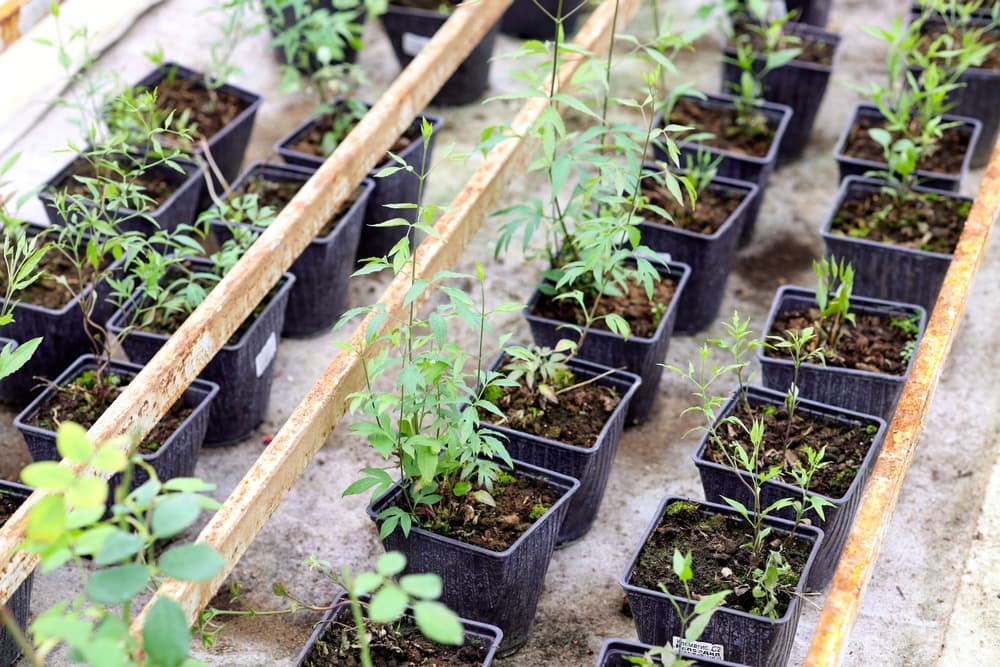
When you’ve found a spot, dig a hearty hole for your clematis to go in. The diameter should be at least 30cm.
Pop the plant in the hole and lean it slightly towards the wall or structure.
This helps to orient the clematis correctly, giving it a better shot at taking hold.
Container Growing
If you prefer to grow plants in containers rather than the ground, you’re in luck here.
C. armandii takes well to container growth if you take time to get the right soil.
Look for flower plant mix, and make sure to use a pot with adequate drainage.
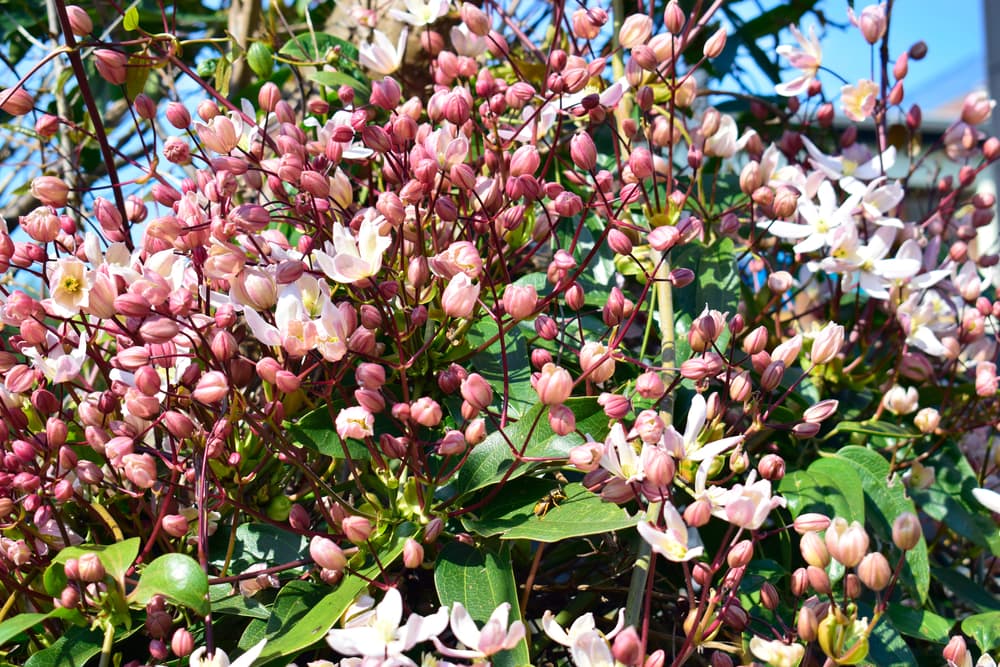
Mulching the base of the plant is a good way to aid moisture retention, and doing so will have a noticeable effect on growth.
To accommodate a growing clematis, choose a pot at least 40cm in diameter.
You’ll most likely need to repot every couple of years to give the plant space to thrive.
Fertilising
Adding a little compost or manure when you plant out your clematis will encourage healthy growth from the outset.
This plant doesn’t require frequent ongoing composting.
Watering
C. armandii likes regular watering, especially through summer.
Take care to keep the soil moist and not over-saturated.
As we mentioned previously, good drainage and a layer of mulch stand your plant in good stead to get the required amount of moisture.
Pruning
“Some clematis supposedly should never be pruned, such as C. armandii and C. montana types, but sometimes they just outgrow their space and you have to hard prune,” says Fiona.
“I have a C. armandii type which is large in a small garden and I prune the left side one year and the right side the following year and this works just fine.”
Pruning C. armandii can be a great way to keep it in check and encourage a fuller and healthier bloom next year.
“It is sometimes recommended not to prune C. armandii back hard, but I have cut it back successfully too,” shares Master Horticulturist Colin Skelly.
“Ideally, select a location where it can fully express its vigour and fill a large space, but for many gardeners with less space, the only option is to control the growth.
“Cutting back areas on a rotation after flowering is a pragmatic way of keeping a good amount of flowers whilst keeping growth within bounds.”
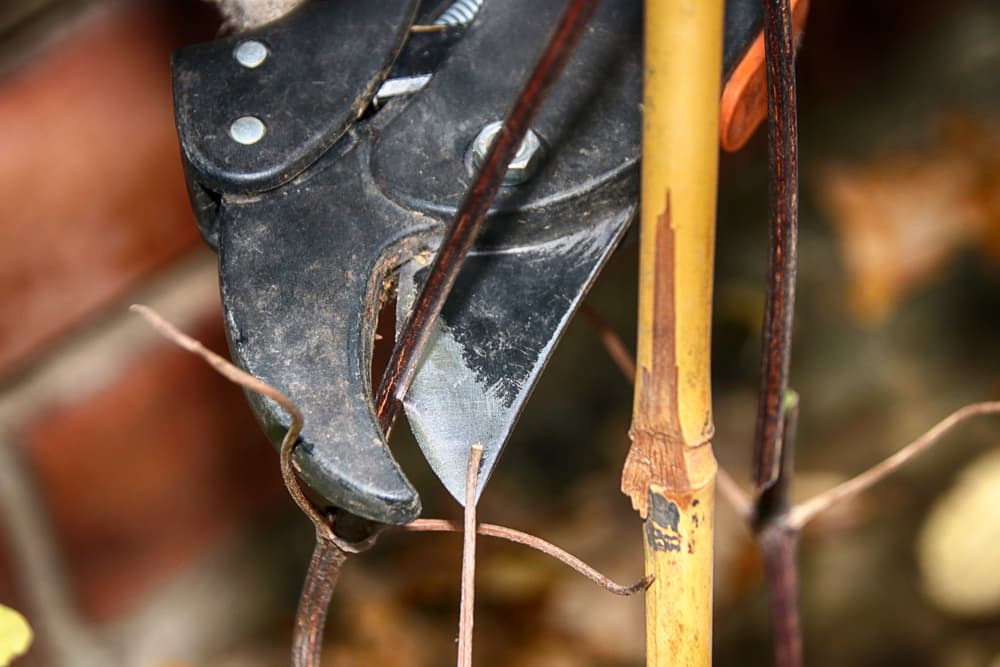
The plant’s early bloom lends itself well to pruning at the end of each season. Here’s what you’re looking to do:
- Prune in February or March depending on when your clematis’ bloom finishes
- Trim about 40-60cm from any stem which flowered
- Remove any dead wood
“You can pinch out the clematis stems to make the plant bushier and get more flowers,” suggests Fiona.
This plant requires very little care compared to some others and will bounce back well from overzealous pruning.
This offers great peace of mind to less experienced gardeners who may be wary about taking the secateurs to their prized flowers!

Common Problems
Thankfully C. armandii is fairly resistant to disease, although you’ll need to keep your eye out for some hungry critters.
“Sudden die-back can be an issue,” explains Peter Skeggs-Gooch from Thorncroft Clematis & Climbers.
“However, it is very rarely true clematis wilt and is usually caused by something physical, like slug or snail damage on the stems.
“If the damage is bad enough, it can cause the stem to die back, shrivel and go brown, resembling the appearance of wilt.”
Slugs, Caterpillars & Aphids
Obviously C. armandii is a tasty treat, as it attracts the who’s who of hungry garden visitors.
If you see telltale holes in the leaves of your plant, one of these three pests is probably the culprit.
For all, you can manually remove the offending insect from the plant, then apply some herbicide spray to discourage further visits, as Peter shares:
“Cut out affected stems and improve support for the healthy stems from the soil level to the wall or fence they are growing on, as that way, they won’t crack and fall near the floor. Then you can try and prevent further slug damage.”
Slugs are fairly easy to trap, and depending on how creative you’re feeling you have a few options (beer trap, anyone?).
References
- 1Clematis armandii. (n.d.). North Carolina Extension Gardener Plant Toolbox. Retrieved March 14, 2023, from https://plants.ces.ncsu.edu/plants/clematis-armandii/
